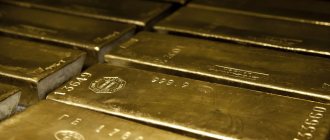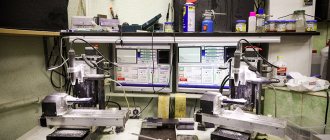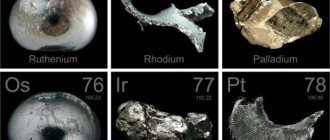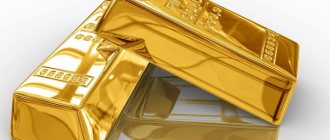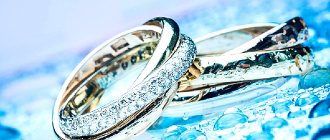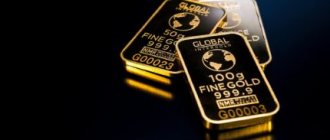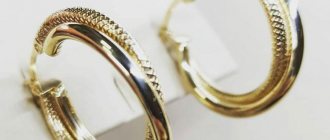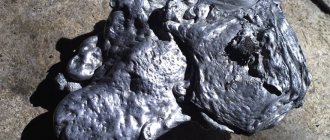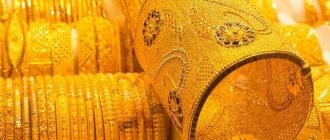What it is?
Noble metals are distinguished from other elements by their ability to maintain their molecular structure under the influence of an unfavorable environment. They cannot be decomposed, and the melting point of these elements is extremely high. They do not react with oxygen and do not produce oxides. Alloys with precious metals can only be obtained through complex chemical manipulations using the strongest reagents.
The mass share of precious metals in the total production of natural resources is very small, which explains the high price of these elements, as well as their special status.
A complete list of names of precious metals was prescribed in 1998 in the Federal Law “On Precious Metals and Precious Stones”. According to Russian legislation, platinum and five of its group metals, as well as the popular silver and gold, are considered precious.
History of appearance
Noble metals are a valuable and non-renewable natural resource. None of the precious metals can be obtained experimentally, so for the scientific community the appearance of these elements on Earth still remains a mystery. At the moment, there are two working versions of their appearance:
- Space. Proponents of this hypothesis believe that we owe the appearance of precious metals in the earth's crust to meteorites that bombarded the Earth at the dawn of its formation. However, this version has a serious drawback - scientists have found that the average meteorite contains only about 0.005% of the total weight of noble metals, which in no way correlates with the volumes mined at different deposits.
- Tectonic. According to this assumption, all precious metals were born under the influence of high temperatures and in the presence of special conditions in the core of the planet, and then were thrown to the surface with lava flows. This version has more supporters than the space version, however, it cannot answer all the questions. In particular, it is not clear why these natural resources stopped forming again and entering the upper layers of the earth's crust along with volcanic lava emissions.
The question of the origin of noble metals and their alloys is one of the most important. If scientists are ever able to answer it, it will change the entire existing system of relationships in the world.
Working with a new alloy
Each new alloy has its own characteristics and it is necessary to study and take into account the differences in their processing, perhaps with slight deviations from the methods of working with a similar alloy.
Standard silver is an alloy that has performance characteristics that are familiar to all jewelers and silversmiths. Working with the new alloy must be done differently in some aspects. Shiny silver alloys, when not oxidized during annealing, show other visual indicators of temperature and therefore it is easy to raise the temperature by going through solidus without even noticing it. The jeweler should focus on the red heat, and not on the appearance of black scale. Adaptation to a new alloy requires some effort and a departure from the usual technique.
Which metals are noble and their properties?
This group of metals received the name “noble” due to their special characteristics. Depending on the variety, their physical and chemical properties may manifest themselves to varying degrees, but they always remain unique.
Rhodium
Rhodium is a member of the platinum group. It is a light metal and has a pale blue color. It is distinguished by a high degree of hardness and, at the same time, fragility.
Valued for its high reflectivity and resistance to chemical attack. Rhodium can only be oxidized with hot sulfuric acid. The melting process begins when heated to almost 2000 °C.
Platinum
Because of its white luster, platinum, discovered in the mines of America, was originally called “silver.” Only in 1751 platinum received the status of a precious metal, and its value instantly surpassed the then known silver and gold. It has high ductility and can be easily forged (which is why it is loved by jewelers). At the same time, platinum is harder than gold, refractory, resistant to chemical influences, and not subject to oxidation.
Gold
Like platinum, it has good ductility and malleability, but has lower melting points. Reacts only with aqua regia, invulnerable to alkalis, salts and acids. In nature, specimens of pure gold with a pronounced yellow color and characteristic shine are rarely found. Most often, miners encounter green faded ore.
Osmium
The most refractory of the noble metals. The melting point reaches 2700 °C. In addition, osmium does not dissolve in acids. External characteristics are white and hard. Belongs to the group of heavy metals.
Iridium
Like osmium, it is a heavy metal. The most durable, dense, refractory and insoluble in acids, gray-white in color. The melting point is slightly lower than that of osmium and is 2454 °C.
Ruthenium
In terms of external characteristics, ruthenium can easily be confused with platinum. The noble metal resembles iridium in its melting point and has increased strength and density. It is interesting that only ruthenium and osmium form water-soluble cakes under the influence of alkali, oxidizing agent and high temperatures.
Palladium
Soft, malleable, white with a silver tint. When heated to 860°C, palladium forms oxides, but becomes pure again as the temperature rises further. The melting point is 1554 °C.
Silver
Among the noble metals, silver has the lowest density and a relatively low melting point - 960 ° C. It is best forged and serves as an excellent heat and electrical conductor. It practically does not react with acids, but darkens under the influence of hydrogen sulfide, which is part of the atmosphere.
List of semi-precious metals
In jewelry production and instrument making, metals are actively used that are not essentially precious, but have a certain value. They are conventionally called semi-precious. Among the most popular types are the following:
- titanium;
- tungsten;
- cupronickel
Their price fluctuates in the average price range and does not exceed $2 per gram.
Main characteristics and features
So, the eight existing noble metals are united by similar physical and chemical properties, which, in addition to resistance to oxidative and corrosive processes, include:
- softness;
- high plasticity;
- incredible strength;
- excellent thermal conductivity;
- high refractoriness (except for silver and gold);
- good ductility;
- excellent electrical conductivity.
Also, among the characteristics of substances of the noble category, it is worth especially noting their beautiful appearance. Thanks to the highest chemical resistance, products made from such materials retain their attractive, shiny appearance for a very long time.
For comparison, the most striking counterexample is copper. The initial appearance of products made from this base metal is practically not inferior to jewelry in terms of bright shine and beauty. But the attractive appearance disappears very quickly - upon contact with air, the element reacts and the oxidation process begins. As a result, a kind of film or, in other words, plaque is formed on the surface of the metal, which is why the product becomes dull and changes its original shade.
Representatives of the precious metals of the noble group constitute a single category of elements. But, of course, each of them has its own individual characteristics.
Gold (aurum)
A truly unique element is the only metal in existence that, in the form of a pure substance, has such a bright, expressive yellow color. The chemical resistance of gold is noticeably higher than that of its “comrades” in the noble category.
Even such well-known destroyers as:
- alkalis;
- salt;
- acids;
- high temperatures;
- moisture.
The density of gold is 19.3 g/cm3. This substance is one of the densest and heaviest among metals. The melting point of the metal exceeds a thousand degrees Celsius.
Silver (argentum)
This light gray metal stands out among its peers due to its excellent reflectivity. Silver, of course, is inferior in weight to gold. The same applies to density - it reaches only 10.5 g/cm3. The melting point is 962 degrees Celsius.
There are two types of acids with which silver reacts:
- salt;
- fluorescent
Resistant to moisture. But it darkens under the influence of hydrogen sulfide in the air.
Platinum and “subsidiary” representatives
A worthy rival to gold for the title of heaviest metal. The density of platinum is 21.5 g/cm3. This white-silver shiny substance melts at a temperature of 1773 degrees Celsius.
Representatives of the platinum group and their individual properties:
- Palladium (palladium). Unlike other noble representatives, under certain conditions this silver-colored substance still oxidizes. These conditions consist of heating in the temperature range of 300−860 degrees. However, if you exceed the upper threshold, the resulting oxide deposit will disappear, and the metal itself will become even lighter. The density of the substance is 12 g/cm3. And palladium melts at a temperature of 1554 degrees Celsius.
- Rhodium. The bluish substance has good reflectivity almost on par with silver. A hard but rather brittle metal. Its density is 12.4 g/cm3. The temperature required to melt rhodium is 1962 degrees Celsius.
- Ruthenium. Outwardly, it is almost identical to platinum, but in its properties and characteristics it is close to rhodium. In particular, this concerns density. In terms of melting point, among all the noble group metals it is second only to osmium and iridium. For ruthenium it is 2330 degrees Celsius.
- Iridium. The gray-white substance is identical in properties to ruthenium and rhodium. But in terms of density it surpasses even platinum - for iridium this parameter is 22.4 g/cm3. In terms of melting point, this metal is one of the top three among the elements of the noble group (together with ruthenium and osmium). Iridium melts at 2466 degrees Celsius. This substance is the most resistant metal. It is not affected by acids, salts, or any chemical elements.
- Osmium. The white substance is completely impossible to dissolve in acid. This is the absolute champion among noble substances both in heaviness and density, and in melting point. The latter in osmium reaches 3035 degrees Celsius, and the density is 22.5 g/cm3.
How are they mined?
Placers of precious metals are practically no longer found on the surface of the Earth. For example, gold mines are a kind of underground reservoirs in which ore is first turned into solution, and then filtered and sent for further processing.
The extraction of silver and other precious metals occurs in parallel with the extraction of the main mining ore, such as copper or lead. This is explained by the insignificant content of platinum group precious metals in the earth's crust and the unprofitability of their extraction. Silver is also quite rare in its pure form and makes up only about 20% of the total ore.
How are precious metals processed and purified?
The ore obtained by miners is unsuitable for use without preliminary cleaning and processing. It will be convenient to consider them using the example of gold, which is mined in large quantities.
The very first stage of processing for a long time remained cyanidation of gold ore, but over time this method developed into heap leaching. The method involves exposing the ore to cyanide and then filtering the resulting gold sediment - concentrate.
The concentrate undergoes a series of physical and chemical studies, background radiation testing, and only after that it is sent for further purification - refining. In a nutshell, refining is the liquefaction, straining and recovery of the original material, the only difference being that the recovered gold has no impurities. The gold alloys obtained after refining can be sent for casting into ingots.
Analysis
The noble metal analyzer aims to answer two main questions:
- what kind of raw material is in front of us: pure precious metal or an alloy with an insignificant content of a noble element;
- what is the percentage of precious metal in the alloy mass presented for analysis.
The first sample is qualitative, the second gives a quantitative result. They are performed in strict sequence, one after another. After conducting a qualitative test, establishing that the alloy actually contains a precious metal, you can proceed to determining its quantity. If, when examining the analyzed sample by reacting with assay acid, nothing remains, then it is a base metal.
The results established during the examination were reflected in the samples. This is a numerical marking; it shows the percentage of precious metal in the presented alloy.
However, it should be borne in mind that the test in Russia is not applied to all alloys, but only to those in which the concentration of the noble element is more than 30%.
Areas of application
Platinum, gold and silver are familiar to everyone in jewelry. However, the main use of precious metals is in the instrument making industry. They are used in the space, mechanical engineering, automotive, food industry and other areas.
For example, rhodium, due to its distinctive chemical properties, is used as a coating on silver and gold products, which significantly extends their service life and protects them from mechanical damage. Iridium is indispensable in the production of watches and in the manufacture of devices for the chemical industry.
Product marking
In the production of technical products for various purposes and jewelry, precious metals are used exclusively in the form of alloys with other metals.
Precious metal alloys get their name from their main component (gold alloys, platinum alloys, etc.). The main materials used for jewelry are gold, silver, platinum and palladium.
Other platinoids (rhodium, osmium, iridium and ruthenium) are added to precious metal alloys in order to adjust the physical and technical properties of the product being manufactured - color changes, ductility and hardness, heat resistance and melting point.
To identify products containing precious metals, markings are used (from German markieren - to put a mark, a symbolic mark) with marking information applied in the following ways:
- using a mark (branding) directly on the surface of the product - for jewelry;
- entries in product passports, forms, labels, operating manuals, reference books and catalogs.
Purpose and methods of branding
According to the “Regulations on hallmarking and hallmarking of products made of precious metals...” (Decree of the President of the Russian Federation dated October 2, 1992 No. 1152), all jewelry and household products made from precious metals for sale must be branded with the state hallmark (clause 2 ).
The mark is applied only when the jewelry is made in accordance with all official canons and meets state quality standards.
The absence of a mark clearly indicates that it has not passed the inspection of the state inspection service, or was simply not presented to it and is being sold in circumvention of legal regulations.
Another marking on the product is the name tag, which is an imprint designating the manufacturer who manufactured the product.
Selling jewelry made of precious metals without a name stamp and inspection by the assay service is illegal.
At its core, hallmarking is an assay-technological operation of applying an hallmark to products made of precious metals. The method of its application is determined by the degree of complexity of the shape and purpose of the product on which the marking must be applied.
Currently, three branding methods are used:
- A mechanical or impact method of applying a mark, based on mechanical action on the surface of the jewelry (hitting a tool with a mark on the tip with a hammer after applying the mark to the surface of the product). Until now, about 80% of all products made from precious metals are branded in this way. Only the hammer has been replaced by automated stamping machines.
- Electroerosive or electro-spark method, which is essentially the burning of a mark with an electric spark. This branding technique is convenient for working with fragile hollow products. About 10-20% of all jewelry products are branded using the electrospark method.
- Laser method, in which the outline of the mark is applied with a laser. This mark is small in size, but has clear outlines. It is considered the only way to brand convex and concave hollow products.
How to read the mark?
The mark consists of two marks, which are either applied separately or presented together on one print:
- images of the sample mark;
- identification design - a five-pointed star with a hammer and sickle (for products produced before 1994) or a female head in a kokoshnik with a profile turned to the right for products of a later release, as shown in the table below.
The presence of an identification mark indicates that it has been assayed and stamped by the Assay Supervision Inspectorate.
The shape of the mark depends on the type of noble alloy. Below are sketches of hallmarks:
Where can I buy or sell?
The main lots on the market remain platinum and gold. If you represent a company or have an individual entrepreneur, it is more profitable to buy metals from officially registered brokerage companies that work with leading manufacturing plants.
Expert opinion
Lyudmila Pestereva
Our most experienced gold investor
Ask a Question
It is easier for an individual to cooperate with banks that offer a wide range of services for the purchase of precious metals. For example, buy bullion and put them in your own cell, open a deposit and even make money on your investments.
Which precious metal is the most expensive?
If we are talking about the most popular and popular metals, then the leading place in the price ranking is occupied by palladium, platinum and gold.
However, Californian is rightfully considered the most expensive metal on earth.
It is mined during the operation of powerful nuclear reactors. The price for 1 gram of Californian is 6.5 million dollars. Next on the list of expensive metals is rhodium. It is estimated at 225 thousand dollars per gram.
Is it profitable to invest in precious metals?
Of course, the rarest metals are valued many times more, but professional investors do not recommend buying them. For successful investments, it is better to choose the most common metals that are in stable demand. Now it is palladium, platinum, gold and silver.
To understand how profitable it is to invest in these metals, it is enough to look at the tables of price changes and profits provided by the Central Bank. Gold | USD | 1 oz
XAUUSD chart courtesy of TradingView
Gold shows the best results in terms of stability.
According to official data over the past 10 years, palladium has proven to be the most profitable investment.
For example, in 2010, one gram of this metal brought investors almost 125 rubles. However, this same metal turned out to be the most unstable. Price crashes happen extremely often.
Palladium | USD | 1 oz
Schedule PL1! provided by TradingView
Investment methods
The list of possibilities here is quite wide, but they all have their pros and cons:
- Buying bullion. The easiest way to invest. However, when selling, you will have to pay 18% VAT, and when selling to a bank, you will also have to pay 13% income tax.
- Buying coins. Collectible coins are not the best type of investment. Reason: high cost and 18% VAT. They are of greater value to numismatists than to professional investors.
- Shares of companies mining precious metals. They can bring large and constant income, but there are also some inconveniences: they can only be bought on the stock exchange, and you cannot do without the services of an experienced broker.
- Securities. Quite a new but interesting way of investing. You can buy securities on the stock exchange. Each security is backed by 3.1 grams of gold reserves held by HSBC in London. The only downside: with a modest investment, you won’t be able to cash out the papers in real gold.
- Bank account. There are two options here: a COX account or a compulsory medical insurance account. In terms of generating income, it is the second option, an impersonal metal account, that is interesting. According to the principle of operation, this is nothing more than a foreign currency deposit. The interest on deposits is small, but if the price of metal rises, you can make good money on the difference in prices. Taxes on gold bars purchased under compulsory medical insurance are paid only if the owner decides to cash out the account after receiving the metal in hand.
Expert opinion
Lyudmila Pestereva
Our most experienced gold investor
Ask a Question
Of all the investment methods described above, the most effective is the compulsory medical insurance contribution. However, for those who keep their finger on the pulse of the cost of precious metals or know a good broker, I advise you to try more interesting options. For example, shares or securities.
Spring gold alloys
The next challenge I set myself was to provide a harder 9k yellow gold for the earring arm, which constantly flexes as it opens and closes. When the earrings are put on and taken off, the bow bends and the main load is placed on the points where the solder is laid.
I was aware that palladium ligatures for 18k gold were quite resilient, so it made sense to try using this formula on the back of the earring. This alloy had good elasticity, but unfortunately its color was dull due to the palladium content.
Adding copper softened the alloy a little, but not enough. The alloy was brownish in color. I had already abandoned this work until the customer needed to cast clasps for a necklace. I have had success using this alloy for the tongues in the lock. When cast, the alloy retains its flexural strength. The main disadvantage of the alloy is the limited range of colors, since palladium necessarily produces pallor.
To the ligature for 18k white gold, consisting of copper, silver and zinc, I added 12% palladium and 37.5% gold. We then replaced the zinc with additional copper to try to improve the color when used with yellow gold. Then we reduced the palladium value to 5%.
| Spring carbide gold alloys | ||||
| Gold | Palladium | Silver | Copper | |
| 9K | 37.80 | 5.00 | 27.29 | 30.00 |
| 10K | 42.00 | 4.66 | 25.36 | 27.98 |
| 14K | 58.70 | 3.32 | 18.06 | 19.92 |
| 18K | 75.2 | 1.99 | 10.85 | 11.96 |
We use alloy composition: palladium - 8.1%, copper - 43.7% and silver - 48.2% for 14 karat and 18 karat gold. The latter, due to the increased gold content, gives a much better yellow color. Low karat alloys are still not yellow, but serve the purpose of maintaining flexural strength. This range of alloys has been developed over 20 years and can be used using conventional jewelry making techniques. We make flat springs for Albert locks or wire for springs in Cartier locks.
The main advantage of these alloys is their ability to maintain increased flexural strength even after casting. Consequently, jewelry elements that require spring tension can be made of precious metal.
